I saw two images in my facebook feed yesterday that were so completely at odds with each other I was still thinking about it when I woke up this morning. 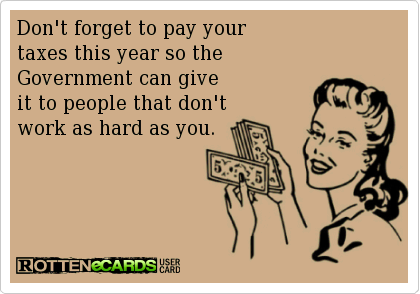 A lovely woman I went to high school with put up the first one along with a self-confessed rant about how much she and her husband pay in taxes and how frustrating it is to make that sacrifice and then see able-bodied people taking advantage of public assistance. Specifically she said, “We work so hard and have to give so much to the govt who then give it to ppl who don’t make an honest effort to work or support themselves or their family. I am all for helping ppl out… Gov programs need to be a stepping stone not a main source of income!” I don’t doubt that she and her husband work very hard or that the taxes they pay are burdensome, but something about the image didn’t sit well with me.
A lovely woman I went to high school with put up the first one along with a self-confessed rant about how much she and her husband pay in taxes and how frustrating it is to make that sacrifice and then see able-bodied people taking advantage of public assistance. Specifically she said, “We work so hard and have to give so much to the govt who then give it to ppl who don’t make an honest effort to work or support themselves or their family. I am all for helping ppl out… Gov programs need to be a stepping stone not a main source of income!” I don’t doubt that she and her husband work very hard or that the taxes they pay are burdensome, but something about the image didn’t sit well with me.
Then I saw the second image. And I thought, why isn’t she more pissed off about military spending? We spend more than the next ten countries combined. The waste in military spending is the number one beef I hear from people I know who have served in the military. And don’t get me started on the VA! They get five cents on every dollar and yet when–I challenge you to tell me–when has that house ever been in order?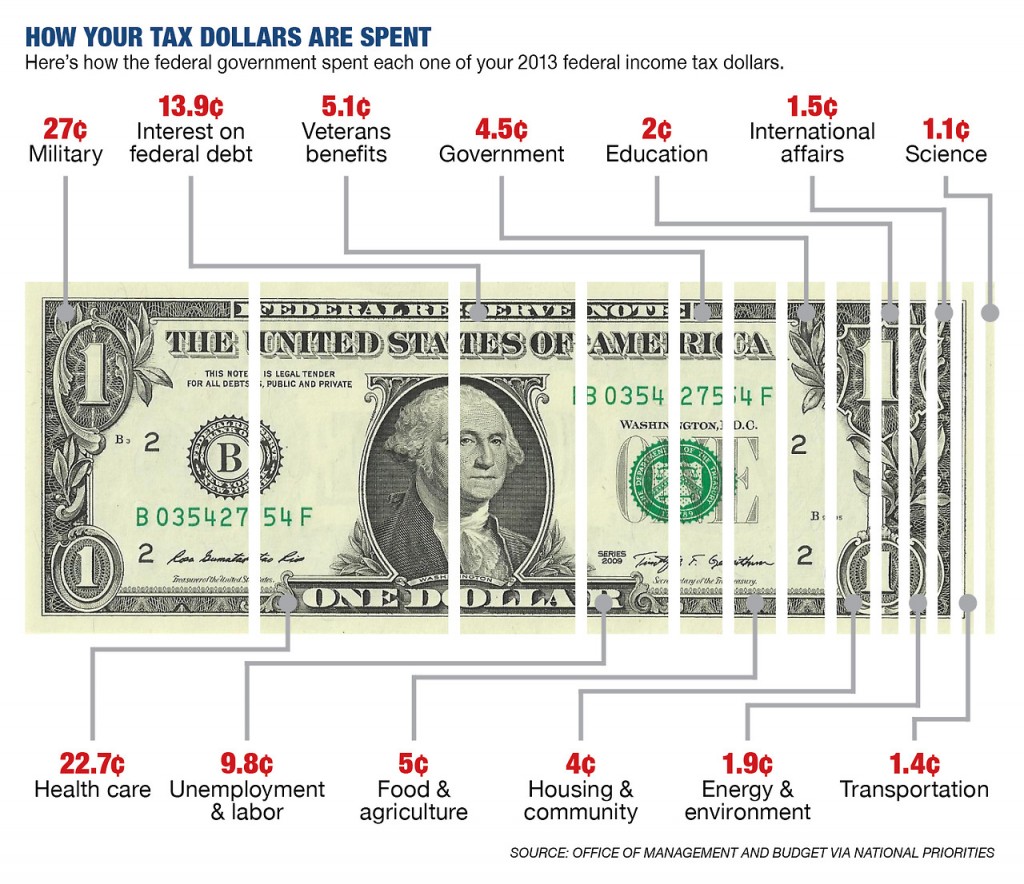
Then I spent too long getting myself riled up about how we expect to maintain our position as a world leader when we only spend two percent of our budget on education. Finally I start to really think about what these numbers mean in terms of her complaints rather than my own. What percentage of these programs go to people who are poor because they don’t work? Because looking at these slices doesn’t really tell us that.
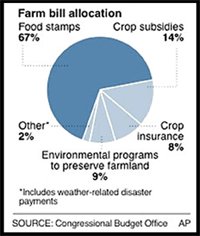 I was under the impression food stamps were a very small part of the agriculture slice, but I was wrong. According to the SNAP website, “In 2010 alone, approximately 80% of all spending from the Farm Bill went toward domestic food assistance programs, with the remaining 10% dominated mostly by commodity programs. In 2010, SNAP benefits totaled $64.7 billion, up from $34.6 billion in 2008 . The increased funding for SNAP has paralleled its skyrocketing enrollment since the beginning of the current economic recession.” So, understandably, we’ve been spending a lot more in this area in recent years, but as the economy improves that spending is leveling out. But for our purposes food stamps comprise about 4 cents of our dollar. According to the New York Times, who got it from the Department of Agriculture, “include erroneous payments to recipients because of errors on the part of the government or outright lying on applications, and the overall loss to the food stamp program is about 4.07 percent.” So at the end of the day we’re spending .001628 of our dollar, less if you take out the government errors, on food stamp scammers. But let’s bump it up to guess-timate the inclusion of people who legitimately qualify because they choose not to work. I’d say double it, but even if we triple it we’re at less than a half of a cent. So let’s round up and say .5 cents of our tax dollar is wasted on food stamps.
I was under the impression food stamps were a very small part of the agriculture slice, but I was wrong. According to the SNAP website, “In 2010 alone, approximately 80% of all spending from the Farm Bill went toward domestic food assistance programs, with the remaining 10% dominated mostly by commodity programs. In 2010, SNAP benefits totaled $64.7 billion, up from $34.6 billion in 2008 . The increased funding for SNAP has paralleled its skyrocketing enrollment since the beginning of the current economic recession.” So, understandably, we’ve been spending a lot more in this area in recent years, but as the economy improves that spending is leveling out. But for our purposes food stamps comprise about 4 cents of our dollar. According to the New York Times, who got it from the Department of Agriculture, “include erroneous payments to recipients because of errors on the part of the government or outright lying on applications, and the overall loss to the food stamp program is about 4.07 percent.” So at the end of the day we’re spending .001628 of our dollar, less if you take out the government errors, on food stamp scammers. But let’s bump it up to guess-timate the inclusion of people who legitimately qualify because they choose not to work. I’d say double it, but even if we triple it we’re at less than a half of a cent. So let’s round up and say .5 cents of our tax dollar is wasted on food stamps.
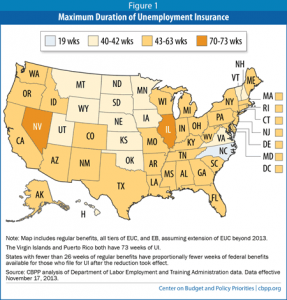 Next we have benefits for the unemployed, but unless you are a policy expert or you’re comfortable getting your data from a special interest group website it’s hard to tell exactly what percentage of the labor budget is spent on unemployment. I really don’t think it matters. In order to qualify for unemployment insurance you have to have worked relatively recently and payed into the pool–it is insurance after all. And in most states you only receive benefits for just over or under a year, so if you decide to throw your hands up in the air and stop looking for work you’re only going to get support for a limited time. But even if you are scamming for those 19 to 73 possible weeks, according to Business Week and the Congressional Budget Office the money we give you is generating even more money by helping the economy continue to grow. To my mind that means there is no waste here.
Next we have benefits for the unemployed, but unless you are a policy expert or you’re comfortable getting your data from a special interest group website it’s hard to tell exactly what percentage of the labor budget is spent on unemployment. I really don’t think it matters. In order to qualify for unemployment insurance you have to have worked relatively recently and payed into the pool–it is insurance after all. And in most states you only receive benefits for just over or under a year, so if you decide to throw your hands up in the air and stop looking for work you’re only going to get support for a limited time. But even if you are scamming for those 19 to 73 possible weeks, according to Business Week and the Congressional Budget Office the money we give you is generating even more money by helping the economy continue to grow. To my mind that means there is no waste here.
Let’s move on to the elephant in the room, healthcare. The three programs that subsidize healthcare costs are Medicare, CHIP, and Medicaid, and I don’t think we’re talking about the first two, which cover care for children, the elderly, and the disabled. For the layman, which I am, it’s not so easy to get the drill down on exactly how much of our healthcare budget goes to Medicaid percentage-wise. But according to the Center on Budget and Policy Priorities two thirds of that spending in 2013 was for Medicare. So let’s say 30 percent went to Medicaid, making it 6.8 cents of our dollar. Expert or not, it’s extremely difficult to get a fix on the percentage of fraudulent claims we pay. The prevailing wisdom is 8 to 10 percent, but most of the data is specific to Medicare and doesn’t break down whether the doctors are profiting or the individual. But I’m willing to be generous here, so we’ll say 10 percent and decide half of that is due to individual scammers. That means roughly a third of a cent of our dollar is going to waste here, but let’s round up again and call it .5 cents.
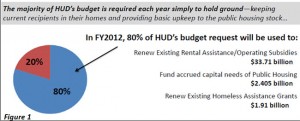 Now we’re on to housing and community costs, which led me to research the spending and reports of fraud in the office of Housing and Urban Development. I had thought HUD was mainly involved in financing mortgages, but I was wrong again. 80 percent of their budget in 2012 went to public housing subsidies, putting roughly 3.2 cents of our dollar toward housing assistance. Here’s the thing, there isn’t a lot of credible information out there on housing fraud that isn’t about mortgages or buried deep in a policy report. Even the news reports are mostly about administrative embezzlement and slumlords. I honestly don’t know how much money we’re being bilked out of here, not by the individual scammer, and the same goes for the energy and environment slice. There is the Low Income Home Energy Assistance Program, but I found even less factual data on fraud perpetrated against that initiative. I feel confident that it’s balanced out by the rounding up in previous categories.
Now we’re on to housing and community costs, which led me to research the spending and reports of fraud in the office of Housing and Urban Development. I had thought HUD was mainly involved in financing mortgages, but I was wrong again. 80 percent of their budget in 2012 went to public housing subsidies, putting roughly 3.2 cents of our dollar toward housing assistance. Here’s the thing, there isn’t a lot of credible information out there on housing fraud that isn’t about mortgages or buried deep in a policy report. Even the news reports are mostly about administrative embezzlement and slumlords. I honestly don’t know how much money we’re being bilked out of here, not by the individual scammer, and the same goes for the energy and environment slice. There is the Low Income Home Energy Assistance Program, but I found even less factual data on fraud perpetrated against that initiative. I feel confident that it’s balanced out by the rounding up in previous categories.
So far we’re spending a penny out of each tax dollar on people who are not making the effort to take care of themselves. But what about TANF? I really did try to figure out what slice of our dollar (as defined in that oh so simple looking graphic) our cash assistance program comes out of…to no avail. I am just a layman after all. I did learn that federal funding for this program is tied to state spending and is delivered in block grants to states. I saw several speculations put it between 0.7 and 1.3 percent of our national budget. Because the states have so much discretion on how this aid is awarded, and to whom, it is almost impossible to get across the board numbers on abuses of the system by individuals. No, it’s literally impossible. What I did learn is that the reforms we’ve put in place over the last twenty years have translated to less people getting emergency assistance rather than people getting less emergency assistance. (If that’s something that interests you, check out this article at The Nation.) But we’re here to talk about where money goes, not why, and I’m willing to do some more generous speculating. Take TANF and throw in the Earned Income Tax Credit (even though it sounds like something you’d have to have a job to get), and whatever other entitlement programs I’m overlooking that could be scammed, and I’m willing to add on another .5 cents.
All together, as your average citizen looking to credible news sources and government budget publications, I gather that we could be spending up to 1.5 cents of every tax dollar to pay for the food, housing, and healthcare of people who do not care to work to take care of themselves. For a married couple filing jointly who earned a net of $100,000 last year the tax bill is $16,857.50 and that translates into $252.86 spent on economic deadbeats. I’m not saying that’s not a lot, but I don’t think it’s the hardship my high school friend imagines it to be. And I’m not saying it’s right, but it’s not wrong enough to condemn our admittedly flawed social safety net.
 Then when I look at graphics like this one it doesn’t even register as the tip of the iceberg regarding the problems we have when it comes to our federal budget. Less because of the extent of our military spending and more because people who abuse entitlements go to jail and pay restitution when we catch them, but people at the pentagon mismanaging military funds do not go to jail. People on Wall Street do not go to jail. And I feel like if my friend really looked at the numbers she’d be pissed off about different things. But that takes a lot of work. It took me all morning. And it’s easier to see that first graphic and be mad at the other people you see in your community who aren’t doing things the way you do them. And, trust me, I know how satisfying that can be. In two seconds you have both identified and solved the problem, right? You spend all morning researching, like me, and all you’ve got are more problems.
Then when I look at graphics like this one it doesn’t even register as the tip of the iceberg regarding the problems we have when it comes to our federal budget. Less because of the extent of our military spending and more because people who abuse entitlements go to jail and pay restitution when we catch them, but people at the pentagon mismanaging military funds do not go to jail. People on Wall Street do not go to jail. And I feel like if my friend really looked at the numbers she’d be pissed off about different things. But that takes a lot of work. It took me all morning. And it’s easier to see that first graphic and be mad at the other people you see in your community who aren’t doing things the way you do them. And, trust me, I know how satisfying that can be. In two seconds you have both identified and solved the problem, right? You spend all morning researching, like me, and all you’ve got are more problems.
But here’s what didn’t sit right with me about that first image… Aside from that two seconds of satisfaction, who benefits? We are a nation ideologically polarized. We have the least productive congress in our history. And as long as we’re busy being frustrated with each other rather than holding the real decision makers accountable, that’s not going to change.
